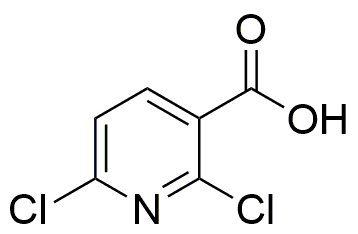2,6-Dichloronicotinic acid is widely utilized in research focused on:
- Agricultural Chemistry: This compound serves as an important intermediate in the synthesis of herbicides, helping to develop more effective weed control solutions in crop management.
- Pharmaceutical Development: It plays a role in the synthesis of various pharmaceutical agents, particularly in the development of drugs targeting neurological disorders, enhancing therapeutic options for patients.
- Material Science: Utilized in the creation of advanced materials, it contributes to the development of polymers and coatings with improved properties, such as durability and resistance to environmental factors.
- Analytical Chemistry: This compound is used as a standard in analytical methods, aiding researchers in the accurate quantification of related substances in complex mixtures.
- Organic Synthesis: It acts as a building block in organic synthesis, allowing chemists to create a variety of complex molecules efficiently, which can lead to innovations in multiple fields.
Información general
Propiedades
Seguridad y normativas
Aplicaciones
2,6-Dichloronicotinic acid is widely utilized in research focused on:
- Agricultural Chemistry: This compound serves as an important intermediate in the synthesis of herbicides, helping to develop more effective weed control solutions in crop management.
- Pharmaceutical Development: It plays a role in the synthesis of various pharmaceutical agents, particularly in the development of drugs targeting neurological disorders, enhancing therapeutic options for patients.
- Material Science: Utilized in the creation of advanced materials, it contributes to the development of polymers and coatings with improved properties, such as durability and resistance to environmental factors.
- Analytical Chemistry: This compound is used as a standard in analytical methods, aiding researchers in the accurate quantification of related substances in complex mixtures.
- Organic Synthesis: It acts as a building block in organic synthesis, allowing chemists to create a variety of complex molecules efficiently, which can lead to innovations in multiple fields.
Documentos
Hojas de datos de seguridad (HDS)
La SDS proporciona información de seguridad completa sobre la manipulación, el almacenamiento y la eliminación del producto.
Especificación del producto (PS)
La PS proporciona un desglose completo de las propiedades del producto, incluida la composición química, el estado físico, la pureza y los requisitos de almacenamiento. También detalla los rangos de calidad aceptables y las aplicaciones previstas del producto.
Certificados de análisis (COA)
Busque certificados de análisis (COA) ingresando el número de lote del producto. Los números de lote y de partida se pueden encontrar en la etiqueta de un producto después de las palabras "Lote" o "Lote".
Número de catálogo
Número de lote/lote
Certificados de origen (COO)
Este certificado de origen confirma el país en el que se fabricó el producto y también detalla los materiales y componentes utilizados en él y si se deriva de fuentes naturales, sintéticas u otras fuentes específicas. Este certificado puede ser necesario para cumplir con las normativas aduaneras, comerciales y regulatorias.
Número de catálogo
Número de lote/lote
Hojas de datos de seguridad (HDS)
La SDS proporciona información de seguridad completa sobre la manipulación, el almacenamiento y la eliminación del producto.
DownloadEspecificación del producto (PS)
La PS proporciona un desglose completo de las propiedades del producto, incluida la composición química, el estado físico, la pureza y los requisitos de almacenamiento. También detalla los rangos de calidad aceptables y las aplicaciones previstas del producto.
DownloadCertificados de análisis (COA)
Busque certificados de análisis (COA) ingresando el número de lote del producto. Los números de lote y de partida se pueden encontrar en la etiqueta de un producto después de las palabras "Lote" o "Lote".
Número de catálogo
Número de lote/lote
Certificados de origen (COO)
Este certificado de origen confirma el país en el que se fabricó el producto y también detalla los materiales y componentes utilizados en él y si se deriva de fuentes naturales, sintéticas u otras fuentes específicas. Este certificado puede ser necesario para cumplir con las normativas aduaneras, comerciales y regulatorias.


